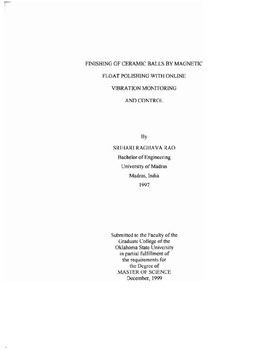| dc.description.abstract | A Polishing shaft was designed to polish a batch of 17/32" ceramic (Si(sub3)N(sub4)) balls by magnetic float polishing with the use of non-diamond abrasives such as B,C, SiC and Ce02� forpolishing purposes, the polishing chamber needs to be aligned with the polishing chamber. The manual method employed in aligning the chamber with the polishing shaft gives way to problems of non-repeatability and inconsistency. Because of this it is possible that a particular run may not produce the desired effect of reducing the sphericity of the balls. A method to detect a faulty set-up by monitoring the vibrations gene rated during polishing has been given. The vibration from the polishing apparatus is recorded with the help of two accelerometer pick-ups, and are sent to Vibroport 41, a vibration-monitoring device, to convert the recorded vibrations to Frequency spectrum Vs time graphs. It has been observed that the lobes or waviness on the surface of the balls, due to high out-of-roundness values, act as vibration generators during polish. Accordingly it has been observed that high out-of-roundness values of the balls being polished generate vibrations with higher amplitude when compared to balls with lower out-of-roundness values. Hence the amplitude of vibrations Vs sphericity of balls curve drawn shows that the amplitude of vibration decreases linearly with decrease in sphericity of balls. Any discrepancy in the linearly decreasing trend indicates a faulty set-up and the polishing run can be stopped without deteriorating the sphericity of the ceramic balls any further. This technique can be very useful to prevent wastage of magnetic fluid, abrasives, ceramic ball material and time by indicating an improper set-up with the help of vibrations generated during polishing. | |
